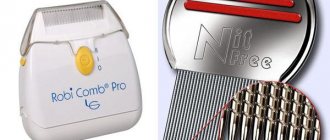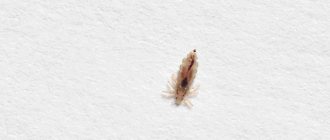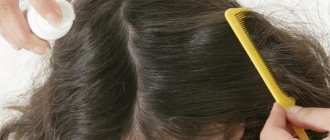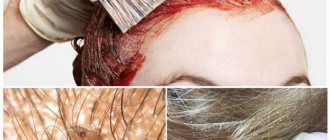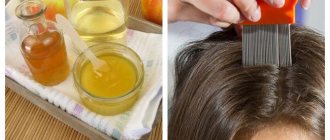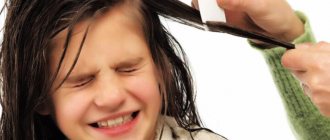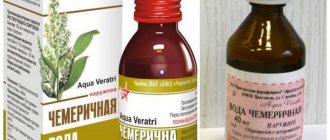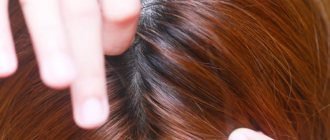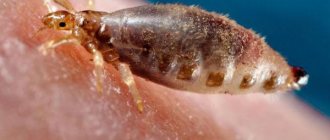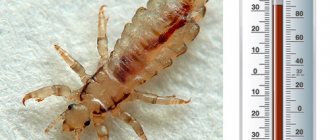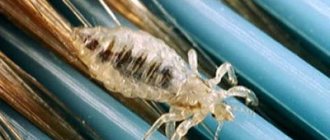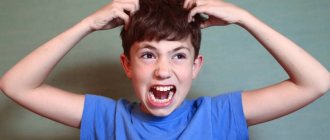Pediculosis, or lice, is considered the most common parasitic disease of the skin and hair. According to data from the World Health Organization, about 30% of our planet's population suffered or are suffering from it.
Infection with lice most often occurs in children, especially those in children's groups, where children are in close contact with each other, and lice, which are not able to fly or jump, simply crawl from one head to another.
Lice feed on blood by sucking it from the scalp, which causes itching, burning and the appearance of wounds through which infection can penetrate. The fight against lice should include the destruction of not only the lice themselves, but also their eggs - nits.
This can be done using one of the most common means. Therefore, in this article you will learn in detail how to get rid of lice and nits with vinegar.
Nits eggs on a child's head
Does vinegar help in the fight against lice?
Despite the widespread use of vinegar against lice and nits, some people mistakenly believe that the product completely eliminates head lice, affecting adults, eggs and nymphs (newly hatched lice). In reality, acetic acid is not toxic to lice, so it cannot directly attack them. Instead, it dissolves the protective layer and adhesive base surrounding the nit. With the help of this shell, the eggs are held on the hair until the nymphs hatch.
The acetic acid method reduces the number of nits in the hair because most of them simply fall off. The remaining eggs can be gradually combed out with a fine-toothed comb. Vinegar does not affect adult lice, but is destructive to fragile nymphs, which generally helps in treatment.
Which vinegar to choose
There are different types of vinegar on sale: table vinegar, rice vinegar, apple vinegar, malt vinegar, grape vinegar, alcohol vinegar, cane vinegar. If you study the reviews of those who have already carried out this procedure, you can conclude that any vinegar has a detrimental effect on blood suckers.
Some claim that grapes contain substances that also strengthen hair. Controversial opinion. Do not get carried away with this method: acid tends to destroy to some extent keratinized particles of the epithelium. There are very few benefits for the hair itself.
Grape vinegar
How to get rid of lice using vinegar
Later in the article we will write in detail about how to remove lice with vinegar. But don’t be surprised if there are still live lice on your hair after the first use. As previously described, apple cider vinegar does not kill parasites. Therefore, to completely get rid of them, you will have to carry out a set of procedures.
The lifespan of one louse can reach a whole month, and a new individual hatches from the laid egg within a week. Therefore, when using vinegar essence to treat head lice, you need to understand that the course will take 3-4 weeks. The procedure can be repeated daily as long as there is an intense nit infestation. But we must not forget that acid dissolves fat in the hair, so the curls may weaken.
Acetic acid and its action
Acetic acid is produced by distilling fermented natural raw materials (juices, wine, ethyl alcohol), has a characteristic odor, and evaporates at low temperatures.
In folk medicine, ordinary table 9% vinegar essence is widely used, which is sold in any grocery store. It is made by adding distilled water to a strong solution of the acid of the same name.
The sharp, specific smell of this substance paralyzes the respiratory system of all types of lice, causing them to die. To increase the effect when treating with vinegar at home, wet hair should be covered with a plastic cap. Those individuals that survived after treatment are weakened and will be easier to comb out with a comb.
On a note!
The acid does not affect the larvae enclosed in the protective shell of the eggs, but it helps to dissolve the sticky substance that attaches the nits to the hair, making them easier to comb out in the future.
Recipe
Existing types of vinegar differ in concentration. For effective removal, it is necessary that the solution contains about 5% acid. Using a product with a higher concentration can cause scalp irritation or even a burn. Regular 9% table vinegar is inexpensive. For the recipe, it is recommended to dilute it with water in a ratio of 1:2 so that the resulting solution contains 4.5% acid.
You can use more expensive and rich red wine vinegar (5-7%). In this case, you need to carefully study the label to find out the actual acid content and calculate the ratio of product and water for the solution. If the concentration is insufficient, the product will not dissolve the nit shell.
The effectiveness of vinegar in the treatment of head lice
Vinegar against lice is considered one of the most effective methods. Insects do not tolerate this substance. After contact with it, lice become lethargic and are easy to comb out.
The acidic product is effective against nits. The acid dissolves the adhesive that lice use to attach their eggs to the hair. Due to this, the eggs dry out and new individuals do not appear.
The disadvantage of this method is the strong unpleasant odor. However, pharmaceutical products do not smell any better. In order not to “fragrance”, you can use not ordinary, but natural apple or wine vinegar.
How to treat your head with vinegar solution
Having a bite available and knowing how to dilute it, you can begin the procedure. It is best to carry out treatment in the bathroom, during water procedures. First, the hair must be moistened with water, but not too much, so that water does not drip from it. Then vinegar is applied to the entire length. Particular attention is paid to the root zone, since it is in this part of the hair shaft that nits attach and hatch.
When processing the head, try to cover the entire volume of hair. For medium-length curls you will need at least two glasses of vinegar. In order not to burn or dry out the skin, intensive rubbing into the head should be avoided. It will take 5 to 10 minutes to dissolve the exoskeletons of nits. After this time, the vinegar must be washed off under warm running water, remembering to close your eyes so that the acid does not irritate the mucous membranes.
Treatment of head lice with vinegar does not end there. Towel-dried hair should be combed with a fine-tooth comb to remove adult parasites and eggs that are not attached to the hair. For greater efficiency, you should use a metal comb designed specifically for combing out lice, rather than a regular comb. With this device, combing will only take 5 minutes.
How can table vinegar cure head lice at home?
Before starting the procedures, I will note the main safety rule when working with vinegar. It needs to be diluted with water! One to one, at least. And when it comes to children, then take two parts water for part of the product. It is better to repeat the session if necessary than to injure the skin.
It is better not to use vinegar essence. But if nothing else is at hand, then dilute it like this: take 20 parts of water per part of the product.
What you need to prepare for the process:
- Vinegar 9 percent 100 ml.;
- Water 200 ml. (adults can take 100 ml.);
- Cotton swab;
- Cellophane cap (plastic film);
- Two towels (one for warming the head, the other for the patient’s shoulders when combing);
- A fine-toothed comb or thick comb.
Step by Step Actions
The product is diluted with water. Apply the solution to the scalp and dry strands using a cotton swab.
Please note that the liquid is applied, not rubbed in, to avoid irritation and redness of the skin. And another important point - it is necessary to moisten every hair, not to give any chance to hide for nasty living creatures.
Next, a greenhouse effect is created on the head
Put on a hat and wrap yourself in a towel. This must be done carefully so that fresh air does not penetrate under the shelter, and uninvited guests lose strength under the vapors of vinegar. Such a turban is kept for half an hour - an hour. Then the head is thoroughly washed with detergent, rinsed thoroughly, and dried with a towel. It is advisable to add droplets of aromatic oils to the shampoo - tea tree, lavender, rosemary. And now the “interesting” part begins. The victim sits comfortably at the table, his shoulders are covered with a towel or sheet. The second person (usually the mother) begins to comb out the remaining parasites on the curls with a fine-toothed comb.
How to properly comb out lice and nits on your head
- I repeat that the curls should remain damp.
- First you need to comb your hair with a regular comb in order to organize it after drying it with a towel. If you have tea tree or lavender oil in the house, put a drop on your comb. The remaining living individuals will “jump out” themselves - they are so afraid of these aromas.
- It is advisable to cover the table in front of which you are going to work with white paper. This way the result of the work will be better visible.
- It’s impossible to comb out every hair, of course. But try to grab a small number of strands in one movement.
- Carefully separate the treated areas with hairpins and elastic bands.
- Clean the comb thoroughly after each stroke. It would be great to have a container of hot water and an old toothbrush nearby. These accessories will help keep your comb clean after every combing. You can add a small amount of vinegar to the water.
- Where the frequency of the comb does not work, nits are removed by hand. Alas, we cannot do without this. After all, every living egg left behind will become a parasite after some time. I don’t think it’s worth talking about what will happen next.
- After combing, wash your hair again.
If I'm not mistaken, then almost all pharmacy packages contain recommendations to comb and rinse your hair with a vinegar solution to consolidate the effect. Isn't it true, the question arises - why pay twice?
To make sure that the table product is effective, I will explain how it works. Acetic acid does not kill lice. They are simply afraid of its smell and want to leave their habitable place. And when wrapped warmly, the heads lose strength (they become numb, like drug addicts, excuse the word), after which they are easier to wash off and comb out.
The persistence of parasites is explained by the adhesive composition that attaches the eggs to the hair. So acetic acid neutralizes this property, due to which most of the eggs are washed off. Well, those that are stuck tightly have to be combed out and selected.
Vinegar therapy must be carried out several times. Don’t delay the next procedure – do it in one or two days. Don't give insects any chance to survive.
How to remove nits with vinegar: precautions
When choosing this method of insect control, it is important to remember safety:
- 1. Acetic acid bleaches hair, so natural hair becomes at least a tone lighter; dyed hair can change color in an unpredictable way.
- 2. Inhaling acetic acid vapor is dangerous, so it is important to use a cap or polyethylene and carry out the treatment in a well-ventilated area.
- 3. Vinegar for nits on thick hair may need to be used every 2-3 days for a week to achieve complete removal of parasites.
Reviews
Alyona:
All carriers in the family should be treated at the same time, and all relatives should be re-treated for lice at the same time. Those of them who do not want to get rid of this problem and do not live permanently in this house, stop inviting them to your place, regardless of whether they are offended or not.
Veronica:
The best way is vinegar. My daughter also once caught lice from a neighbor’s girl, so I used 5% vinegar for her, cleaned it with my hands for an hour, and washed her hair every day, after 3-4 days they were gone.
Elena Alexandrovna:
Do not confuse vinegar and vinegar essence, parents, be careful!
Larisa:
Thank you very much, I did as you said, wet my hair and scalp with vinegar. The girl screamed that the smell was terrible and it stung her eyes, but I made her endure it for 20 minutes. Then she washed her hair with shampoo several times and combed her hair for an hour; a lot of dead lice and nits came out. A day later I examined my hair, it seemed like there was nothing, but either because of the vinegar, my hair became shiny and silky.
Olga:
You won’t burn your hair with vinegar, because vinegar must be diluted with water, and then it will be easy to comb out with a thread wound several times around the comb, and don’t worry, please, this is a very easy procedure, it helps with any hair length.
Apple cider vinegar for lice
Removing lice is also possible using apple cider vinegar. When purchasing a product in a consumer store, you need to make sure that it is unfiltered and pasteurized. Most brands produce apple cider vinegar in a concentration (5%) sufficient to dissolve the nit shell. The use of 3% of the product may not be effective in the treatment of head lice. You should avoid getting malic acid on your clothes because it leaves permanent marks.
Features of use
Children are more likely to suffer from head lice because they are in closer contact with others. Substances used for head lice in children are almost no different from those used for adults.
Vinegar for lice in children can also be used. In a small concentration, it can be used to treat even very young children (from 2-3 years old - before there is almost no possibility of infection).
The only peculiarity here is that children's skin is more sensitive, and significant damage can be caused to the hair, which is especially unpleasant for girls. It is necessary to adhere to several basic rules to avoid unpleasant consequences of treatment.
- Vinegar should be used in a weaker solution , it is better to repeat the procedure later.
- Do not use vinegar essence under any circumstances. You can correctly calculate the ratio of water and acid, but such a risk is not worth it.
- When washing your hair, use a special bandage to prevent liquid from getting into your child's eyes. Rinse your hair several times.
- After treating head lice with vinegar, use chamomile decoction . This plant has a calming effect on inflammation and reduces irritation.
Vinegar and oil for lice
According to research in the field of lice treatment, the following types of essential oils have a toxic effect on nits and lice:
- • ylang-ylang
- • tea tree oil;
- • anise oil
Olive oil and butter have a different effect on lice. Enveloping the adult, the oil deprives it of oxygen, as a result of which the parasite dies. The method involves applying the product to all hair for 10 minutes. The product is then washed off using a medicated shampoo for a more effective result.
Alternative and traditional methods of treating head lice
If for some reason using a mask with vinegar is not possible, you can try other folk remedies:
- Cranberry. The huge amount of acid contained in this berry has a destructive effect on nits and lice. For treatment you will need cranberry juice: to get more of it, the berries are first frozen. After defrosting, the juice will begin to stand out on its own, and the remaining juice will be easier to squeeze out using gauze. The juice should be applied to clean, dried hair along the entire length, gather the hair in a tight bun, put on a cap and leave on the head for 20 minutes. Rinse hair with water without shampoo and comb out lice with a comb, remove nits. Repeat after 5 days.
- Laundry soap. Destroys parasites due to the content of alkali and phenol. The method is simple, but the process is lengthy: you need to wash your hair with laundry soap for a week 3-5 times a day. After each wash, comb out lice and nits.
- Kerosene. Its effectiveness in combating parasites was known back in the last century. Kerosene is guaranteed to kill lice; the parasites die from intoxication with the substances included in its composition. Kerosene is also harmful to humans, so it should be used only in particularly advanced cases. Kerosene is applied to the hair for 15-20 minutes, then thoroughly washed off with concentrated shampoo under running water. Hair is combed thoroughly.
- Vodka. Effective against parasites, but this remedy is not suitable for children and pregnant women. It is applied to dry, clean hair along the entire length, kept for half an hour under a cap and washed off with shampoo. Then nits and dead parasites are combed out.
- Hydrogen peroxide. A strong oxidizing agent that can eat away the insides of lice in five minutes. The shells of nits cannot be dissolved, so they will have to be combed out. This will be easy to do, since the peroxide will dissolve the glue that attaches it to the hair. Before use, hydrogen peroxide is diluted with water in a ratio of 1:2. The exposure time on hair should not exceed 20 minutes.
- Curling iron and a hair straightener. Treating your hair with these devices will kill lice and nits instantly. The death of the parasites occurs in 1-2 seconds; the shell of the nits also bursts from exposure to hot metal. It is important to apply a heat protectant to your hair before treatment to avoid damaging it.
Vinegar and Tea Tree Oil Recipe
The specific smell of tea tree oil helps repel and destroy lice. Add 5-10 drops of oil to the prepared vinegar-water solution and stir. The mixture is applied to a sponge and rubbed into the scalp and hair.
After 25-30 minutes, the mixture is washed off with plenty of water and shampoo. Then it is recommended to apply a few more drops of one oil to the strands. This can be done conveniently using a sponge. The procedure must be repeated 3 times over several days.
Processing rules (step-by-step instructions)
- The medicinal mixture is applied to washed, dried hair - from the roots along the entire length of the strands. For better moisturizing, use a sponge and a piece of cloth, regularly moistening them in the solution.
- After treatment, you need to put a plastic cap or a regular bag on your head. This creates a greenhouse effect and also increases the concentration of acetic acid vapor.
- The time of the procedure is determined depending on the sensitivity of the infected person to the components of the remedy. The longer the exposure time, the more lice, their larvae, and nits can be removed from the hair.
- Dead lice and their eggs are combed out with a fine comb, regularly moistening it in a vinegar solution or wiping it with a previously prepared cloth. The treated strands must be separated from the rest of the hair.
- To control the number of insects removed and to prevent re-infestation by surviving parasites, the shoulders and floor under the patient are covered with a cloth before combing them out. It is important to carry out this work in a room with good lighting. Used fabric should be carefully rolled up and thrown into the trash. The second option: place the combed insects in a container with vinegar and after they die, wash them down the drain. Boil the sheet (fabric) and iron it on both sides.
- The number of procedures is determined by the absence of parasites when combing hair after treatment.
Additional Information! Vinegar can be combined with other drugs. The effect of the acid will increase if it is used in combination with hellebore water, cranberry juice or wormwood decoction.
Contraindications and precautions
Vinegar-based products are not recommended for persons with individual intolerance to the product, as well as for those with extensive wounds on the scalp. It is better for pregnant women and people suffering from bronchial asthma to refrain from using vinegar to remove lice or take a solution with a minimum concentration.
The use of any of the recipes based on a water-vinegar solution requires compliance with precautions, namely:
- • ensure that vinegar does not get on open areas of the body or in the eyes;
- • protect your skin with a towel and your eyes with safety glasses;
- • during the procedure, do not allow the child to touch the head and hair with their hands;
- • do not use undiluted product, especially when removing lice from children;
- • if dizziness, nausea or shortness of breath occurs during the procedure, the person should be taken to fresh air;
- • if you feel a strong burning sensation on the skin, treatment should be stopped;
- • if vinegar accidentally gets into your eyes, you should immediately rinse them with plenty of warm water;
- • treatment of the head with vinegar solution should be carried out in a well-ventilated area.
Repeated use of the product may have a negative effect on the condition of the hair. They become thin and brittle. The effect of vinegar on colored hair is especially undesirable.
Side effects and possible consequences
If you overdo it and make the solution too concentrated, you can get a chemical burn to the scalp.
Even if all the rules are followed, the hair after the procedure may become dry and brittle, to avoid this, you should use appropriate shampoos and make hair masks for some time after the procedure. If your hair is dyed, its color may change.
To avoid side effects you should:
- Do not exceed the recommended vinegar concentration of 4-5%;
- Do not leave the mixture on your hair for more than the recommended time;
- If unpleasant sensations (itching, burning) occur, the medicinal composition should be washed off immediately.
The main side effects are dry hair, brittleness. Due to the treatment of head lice with vinegar, a change in the color of the strands is possible, especially in cases with dyed hair.
Other folk remedies
The simplest and at the same time radical home method of combating head lice is to cut your head bald. Since lice attach their eggs to hair in the root zone, the absence of hair eliminates any possibility of parasite activity. But not everyone will feel comfortable with a bald head.
Kerosene remains a popular method of treatment despite the fact that it can cause severe burns to the skin. Technical clarified kerosene somewhat minimizes the risk. The medicinal composition is as follows:
- • 1 tablespoon of kerosene;
- • 2 teaspoons olive oil;
- • 1 teaspoon of shampoo
The suspension is applied to the hair, then the head is wrapped in a plastic bag and wrapped in a towel. Leave in this position for an hour and rinse the mixture from your hair using shampoo. It’s a good idea to rinse your curls with a weak vinegar solution. The procedure is repeated after 3 days, but with a lower concentration of kerosene. Do not forget that kerosene fumes are flammable, so care should be taken.
Prevention of infection
There are no methods of prevention that provide a 100% guarantee of protection . The disease has long ceased to be the scourge of dysfunctional families and does not depend in any way on personal hygiene. Lice prefer well-groomed and clean hair, so frequent hair washing will not save you from infection.
IMPORTANT: if you find lice on a child, report it to the educational institution. Otherwise, children will infect each other in a circle and treatment will be ineffective.
You can protect yourself and your children as much as possible from parasite infection by following simple rules:
- collect hair in a smooth hairstyle, especially for children at school;
- do not try on other people's hats;
- do not use other people's combs;
- do not sit, looking at one gadget “head to head”;
- Wear a rubber cap in the pool.
If a lice epidemic occurs:
- wash your hair with tar soap every 10 days;
- after each wash, rinse your hair with water and 1 tablespoon of vinegar;
- add a few drops of tea tree or eucalyptus oil to the shampoo;
- As a last resort, dye your hair with industrial dye.
Lice can live outside the human head for 48 hours . If infection occurs, it is necessary to wash all linen and clothing at high temperatures, and treat upholstered furniture with a steam generator. What cannot be washed can be taken out into the cold for several hours.
The appearance of lice is an unpleasant but common problem . It can be solved using both pharmaceutical and folk remedies, for example, using ordinary vinegar. It is important to carry out the treatment several times to complete the job and get rid of parasites forever. Following simple precautions will reduce the likelihood of re-infection.
- about the author
- VK profile
